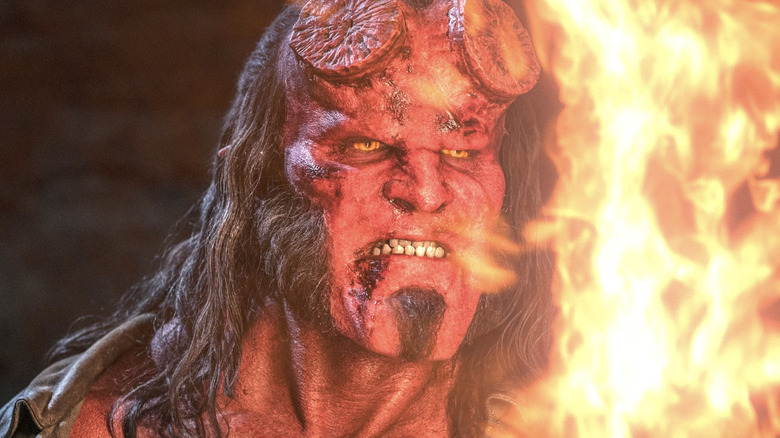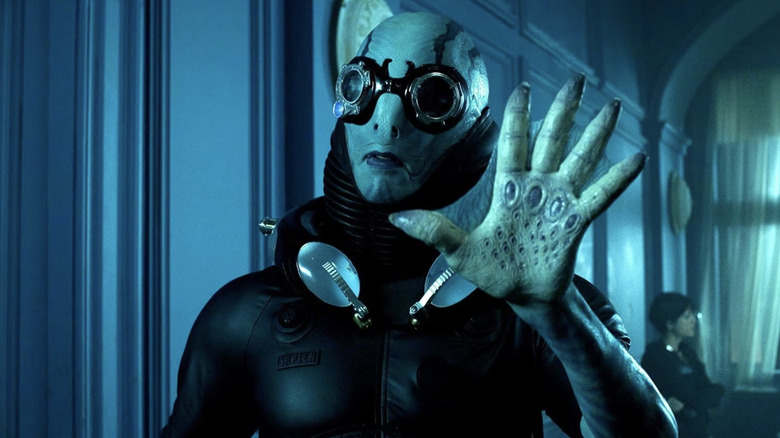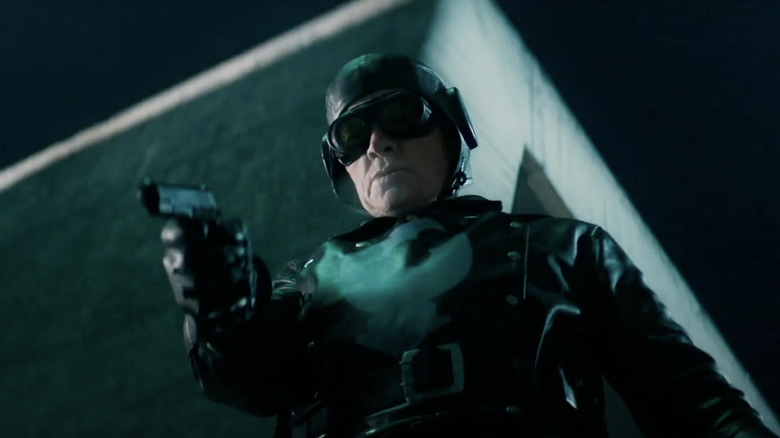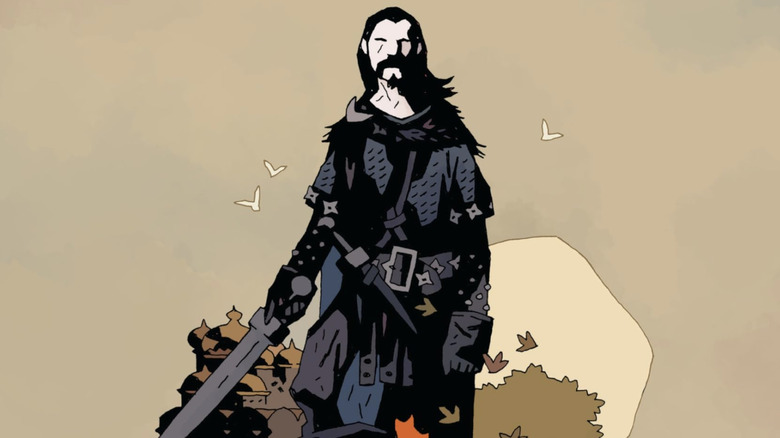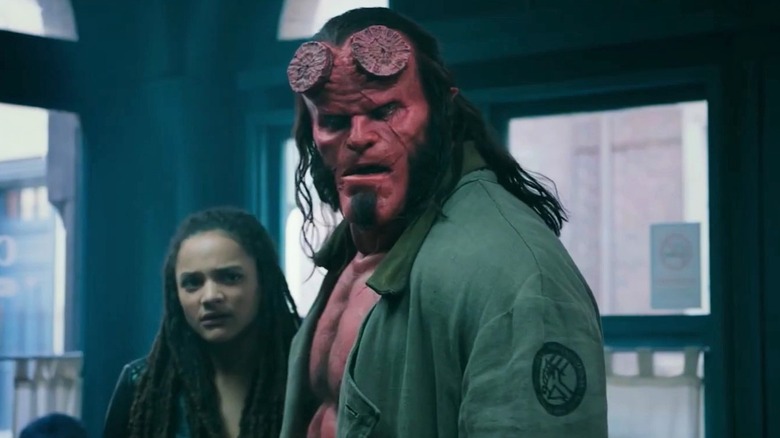What David Harbour's Canceled Hellboy Sequel Would Have Been About
We may receive a commission on purchases made from links.
Marvel Studios' "Thunderbolts*" brought back Alexei Shostakov/Red Guardian (David Harbour) from "Black Widow" and made him into an Avenger. But for a brief moment, Harbour led his very own superhero franchise.
In 2019, Harbour starred in Neil Marshall's "Hellboy." The experience wasn't a positive one; the movie was panned, attracting negative comparisons to the previous Guillermo del Toro "Hellboy" films which it was rebooting, and flopped. When "Black Widow" came out, Harbour said that playing Red Guardian helped him leave the disappointment of Hellboy behind.
Mike Mignola, the creator of the Hellboy character and comics, thereafter pushed forward with a second film reboot —"Hellboy: The Crooked Man," starring Jack Kesy as Hellboy. "The Crooked Man" didn't get a theatrical release stateside, but it found its audience on streaming. So, who knows, maybe there will be another Hellboy movie in the future that learns from the previous ones' mistakes.
The 2019 "Hellboy" is mostly based on the "Hellboy" comic mini-series "The Wild Hunt" and "The Storm and The Fury." Hellboy, summoned to destroy the world, finds his inner darkness bubbling to the surface as the apocalypse looms. Gruagach, a pig-faced fairy with a grudge against Hellboy, then resurrects the ancient witch Nimue to renew her bloody reign. Hellboy, learning he's a descendant of King Arthur by way of his human mother, must thus fulfill his ancestor's destiny and save England.
But the movie adaptation botches those stories. For one, it's a weird choice to start a new film series with a climactic story like this. (In the comics, Hellboy dies defeating Nimue and is sent back to Hell.) Gruagach's (Stephen Graham) pig-man design doesn't work in live action, either. Perhaps that's why the film transforms him from a compelling villain into a punchline.
The Harbour-led "Hellboy" still feels extra disappointing and incomplete because the film was clearly banking on more. Its ending has three different sequel hooks. Talk of a "Hellboy" sequel was quickly dashed, but if you know your Mignolaverse, you can glean what the movie was setting up.
The 2019 Hellboy sequel would've reimagined Abe Sapien
Hellboy's primary co-worker has always been the fishman Abe Sapien (played in the del Toro films by Doug Jones). Hellboy and Abe are both agents for the Bureau of Paranormal Research and Defense (B.P.R.D.). Together, they travel the world to bump back against things that go bump in the night.
To set itself apart from the del Toro "Hellboy" movies, "Hellboy" '19 didn't include Abe or firestarter Liz Sherman. Instead, Hellboy's partners were the seer Alice Monaghan (Sasha Lane) and B.P.R.D. Major Ben Daimo (Daniel Daie Kim), a werecat. Daimo originates from the "B.P.R.D." spin-off comics, set after Hellboy quits the Bureau.
Alice first appeared as a baby in the Hellboy short story "The Corpse," set in 1959. She's abducted by Irish Fae and replaced with a shape-shifted Gruagach. Hellboy then exposes the deception, burning Gruagach with iron to show his true form, and saves Alice.
This is why Gruagach loathes Hellboy, and to tie "The Wild Hunt" even more to "The Corpse," Mignola brought back the grown-up Alice. Touched by the fae, she's over 50-years-old but doesn't look like it. She and Hellboy fall in love; Alice stands by his side facing Nimue, then is left behind to mourn him when Nimue tears out his heart. To grant Alice a bigger role in the action, the 2019 movie adaptation gives her a gun and the ability to summon ghosts.
The final scene of "Hellboy" before the credits features Hellboy, Alice, and Daimo raiding a warehouse belonging to a doomsday cult known as the Oannes Society. There, they discover a water tank holding an "Icthyo Sapien" — that's Abe, whose gilled hand presses against the tank.
Speaking to ComicBookMovie.com in 2019, "Hellboy" make-up artist Joel Harlow confirmed if that sequel had been greenlit, Abe would've shown up. However, his design would've been overhauled:
"If we had done the entire character, first of all, it would be vastly different from the other films, more thug-like, and we wouldn't have even have gone with that hand you see at the end of the film. We would have designed something from scratch. That's one of the ones that, because I have an affection for fish people and fish characters, would have been really fun to work on, but alas, no."
Based on the Oannes Society's inclusion, it seems likely the never-made sequel would've included Abe's comic backstory (he's a mutated 19th century human once named Langdon Everett Caul), which the del Toro "Hellboy" movies never did.
Hellboy 2019's post-credits scene teased a Lobster Johnson team-up
"Hellboy" '19 has two post-credits scenes, both building off of cameos from earlier in the film. There's a brief flashback to Hellboy's origin in 1944, when Grigori Rasputin (Markos Rounthwaite) and Nazi scientists summon Hellboy to Earth, only for Allied troops and the Nazi-hunting vigilante Lobster Johnson (Thomas Haden Church) to break up the party. The Lobster is known as such because he burns a claw insignia into evildoers' heads, which he demonstrates on Rasputin.
In the mid-credits scene, a drunk Hellboy meets the Lobster's intangible ghost in a graveyard. Hellboy melts into a fanboy, but the Lobster warns him that more evil is coming.
In the "Hellboy" comics, the Lobster was a masked vigilante in 1930s New York City. With a group of helpers (a la the Shadow), he targeted gangsters, spies, and the occult. He died storming a Nazi base in 1939 (before Hellboy came to Earth, so the movie was adjusting the timeline a bit).
The Lobster's true identity was never revealed, and the only recorded history of him was pulp novels. So, in the present, the Lobster is remembered as a fictional pulp character "created" by writer Norvell Cooper, who wrote eight Lobster stories and died in poverty. Hellboy is the no. 1 Lobster Johnson fan because Lobster comics were the first things he learned to read, and he maintains (rightfully) that the Lobster was real.
The Lobster first debuted in the "Hellboy" comics mini-series "Conqueror Worm" — his ghost, still bound to the Nazi stronghold where he died, works with Hellboy to complete his final mission. He then starred in several spin-off "Lobster Johnson" comics, revealing what he was up to when he was alive. The Lobster's cameo in "Hellboy" '19 seemed like it was testing the waters for both a future team-up with Hellboy and a prequel film. Due to how "Hellboy" turned out, however, neither happened.
David Harbour's Hellboy would have faced Koshchei next
The "Hellboy" end-credits scene features the Baba Yaga (Emma Tate/Troy James), the witch with a walking house from Russian folklore. She hates Hellboy because he stopped her from abducting and eating several children in 1964, shooting out her eye in the process. In "The Storm and the Fury," Hellboy trades one of his eyes to Baba Yaga for help defeating Nimue. In the movie, he tricks her out of the deal, infuriating her again.
Her anger still burning, Baba Yaga talks to someone unseen. She states that if he kills Hellboy, she'll finally allow him to die. "Hellboy" comic fans (and only them) know who she's talking to: Koshchei the Deathless, based on the Russian folk character.
Once an ancient warrior, Koshchei was blessed (and, in the long run, cursed) to never die. The Baba Yaga tried to seduce him; when he spurned her, she stole his soul (hidden like a nesting doll inside an egg, inside a duck, inside a rabbit, inside a goat, inside of a tree) and enslaved him.
In the comic mini-series "Darkness Calls," Baba Yaga lures Hellboy into her pocket dimension (based on the fairy tale Russia that never was) and sends Koshchei to kill him. Presumably, that's the story this scene was setting up. Koshchei is unseen because, practically, it made sense to not lock in an actor or a costume.
But this also demonstrates why the "Hellboy" reboot shouldn't have rushed into Hellboy vs. Nimue. "Darkness Calls" happens before "The Wild Hunt" and "The Storm and the Fury," and out of that sequence they make less sense.
Why David Harbour's Hellboy reboot failed
As a Hellboy fan who did not enjoy the 2019 film, I still look back on it in disappointment. Harbour himself was almost as perfectly cast as Ron Perlman in the del Toro "Hellboy" films. In his star-making performance as Sheriff Jim Hopper in "Stranger Things," he played a gruff and kind of cynical man of action with the heart of a softie. That's Hellboy.
"Hellboy" '19 is also much closer to the comics than the del Toro films, and I mourn that those Hellboy comics weren't adapted to their full potential.
The first del Toro "Hellboy" movie pulls a fair bit from the original 1994 Hellboy comics mini-series "Seed of Destruction" but includes major changes like making Hellboy and Liz (Selma Blair) in love. "Hellboy II: The Golden Army" leaves Mignola's comic mythology behind for a totally original story and villain.
"Hellboy" '19 dives headfirst into the Mignolaverse, which is the most expansive comic universe out there besides Marvel or DC (and the most consistent one). Not everything about Hellboy and his world can carry over to live-action films (like Mignola's minimalistic art), but you can absolutely spin a multi-movie saga out of them. Unfortunately, in rushing to lay the building blocks, "Hellboy" doesn't offer many reasons why you should stick around to see those blocks be assembled.
A "Hellboy" sequel could have fixed the first film's problems, but it would have had to build on a problematic foundation.
